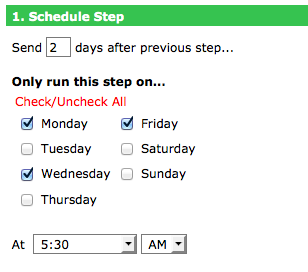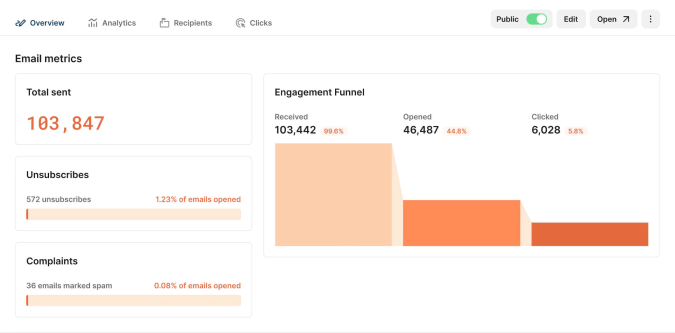Email marketing frequency has been a heated topic for years now. Some people believe one thing, others another.
In virtually every argument I’ve ever seen, the problem was that people try to take ONE stance. There is just one answer. One way of doing things.
This, as you may have guessed, is absolutely the wrong way of doing things.
As you’ll see, there is no right or wrong answer. In this post I’ll cover various aspects of email frequency, how to know which category you fall under, and my best attempt at relating it to all business in all industries.
Let’s start with…
The Importance Of Frequent Emails
I have zero doubts, zero reserves, zero hesitation that the following statement is absolutely true:
You will make more money if you communicate with your prospects and customers more often.
In all my years of business, working with over a hundred different businesses in 40+ different industries, I have found this to be true 100% of the time.
But why is this?
Any type of communication, whether it’s through email, phone calls, one-on-one, direct mail or any other media you use, is about building relationships. By establishing frequent contact you accomplish several crucial factors to growing a business.
- You show your “tribe” that you’re the leading expert in your industry
- You establish trust and credibility
- You prove that you’re in it for the long run (which establishes more trust)
- You increase the likelihood of being top of mind when they decide to purchase
- You’re able to overcome more objections and show them more benefits
Again, all other things being equal, the more you communicate (in this case via email), the more money you make.
But, before I move on, let me clarify something. Communicating frequently doesn’t necessarily mean emailing more frequently. In order to communicate effectively with your customers and prospects they have to be opening our emails, reading them, clicking on links and ultimately converting into sales.
You have to find that fine line where you’re communicating frequently but also adding value. If you stop adding value by communicating too much, they become un-engaged.
If your audience is not engaged, you aren’t communicating properly and will lose sales.
So the next question becomes…
Should You Use Autoresponders Or Broadcast Messages?
If you aren’t aware, a broadcast email is a one-off email. You send it out once, and only current subscribers will see it. Compare this to an autoresponder which you can create once and is then part of your series of emails that new subscribers get automatically.
So which is right for you?
Unfortunately there is no definitive answer for this.
However here are a few guidelines to help you determine which is best for you.
Option #1: Broadcast messages – These are typically better for those who like to tell stories. This way you can relate something that happened to you last night, in an email this morning. They’re also good for people who can stay consistent in sending messages. If you have the dedication to send daily/weekly/monthly emails, and can do this for years on end, broadcast messages are probably perfect for you.
Option #2: Autoresponders – Personally, I like to use autoresponders because they offer an enormous amount of leverage and automation to my business. Many times I get much too busy working with private clients and will neglect sending out an email for weeks on end. By setting up strategic autoresponders, I can keep in contact for months, even years, without actually being there. You get to do the work once and be done with it.
This is where most people stop. They recommend picking one or the other, and leave it at that.
I don’t think that’s right.
Here’s what works for me.
It’s called…
Option #3: The Hybrid Email System
Since I like a lot of automation in my business, I have a lot of autoresponders. However I also like to keep in close contact with my list and get feedback if I’m coming out with a new product… have promotions every once in awhile… and tell stories that couldn’t quite be told in an autoresponder.
You may have a similar way of working.
If so, you can simply set your autoresponder to only send on certain days of the week.
Monday, Wednesday, Friday, for example.

When you have them send out on specific days, you can leave the other 4 days (Tuesday, Thursday, Saturday,Sunday) open for broadcast messages.
This makes sure you don’t double-email on a specific day (which is not necessarily a bad thing, but many people are against it), and also gives you a lot of flexibility in your work schedule so you can easily plan your emails to go out on days that your autoresponder won’t be going out.
I’ve been using this approach for years, and highly recommend it.
But we still haven’t covered the single most important question you’re probably asking…
How Often Should You Email?
Ask 10 people this question, and you’ll get 10 different responses. In fact you’re more likely to see a fistfight break out than you are seeing any agreement.
The reason is because the answer to this question is different for every business.
The short answer to this questions is this:
Email as frequently as you can, as long as you can continue adding real, tangible value to your prospect or customer.
How do you know if you’re adding value? Simple. Watch key metrics such as,
- Open Rate
- Click Through Rate
- Unsubscribe Rate
- Conversion Rate (From email)

Here’s the long answer…
I’ve discovered that 99% of business will fall into one of three categories.
- Email daily
- Email frequently (1-3 times per week)
- Email sporadically
Here’s my take on how to categorize your business.
Email Daily – If you want to prove that YOU are the expert in your industry, you can do so by emailing daily. If you sell an information product, daily emails might be right for you. Some service-based businesses (think marketing consulting or financial planning) also apply. The daily email is also a good fit for people with a large number of products or services they have to offer. If you can write everyday and continue adding value to your prospects or customers lives, do it. Your sales will literally go up overnight.
Email 1-3 Times Per Week – This is best used either if you can’t think of something to write everyday (it’s hard at first, but easy the more you do it), or if your typical prospect/customer is an extremely busy person. For example, if you sell a service such as interior decorating, emailing every single day may or may not be just a little too much to your prospect. If you own an eCommerce store and send out a pitch every single day, you’ll likely be seen as annoying in short order. In these cases, 1-3 times per week may be better.
Email Sporadically – Some businesses simply don’t need to email every day, or even frequently. Think of the pool maintenance man. What if they emailed you 3x per week, even in the winter when your pool was closed? What if your dentist emailed you every day, or a few times per week? What about a house painter… roofer… or accountant? It would be too much. For companies like this, when your service is used on a very infrequent basis, I recommend emailing at least once per month (a newsletter – preferably print – is an easy way to accomplish this), but no more than once every two weeks.
Figuring out the best email frequency for your business requires some deep thought into the minds of your prospects and customers. How often do they want to hear from you? How much is “too much”? Am I annoying them, or helping them?
These are all questions that you need to think about.
Thankfully, I have another solution for you.
It’s something I call…
The Hot Potato Effect
Imagine taking a steaming potato out of the oven. As it singes the hair on your hand, you’re forced to throw it back and forth between your hands. However as time goes on, the potato cools down and you don’t need to throw it back and forth as often.
This is exactly what happens when people become interested in your product or service.
At the moment they sign up for your email list, they’re as hot to buy as they will ever be. Therefore they WANT to hear from you immediately after signing up, and likely every day after that for awhile.
Then, as time goes on, they begin to cool off and don’t want or need your product/service as much.
So here’s what I recommend.
- Design an autoresponder that emails them every single day, for a specific amount of time. For simplicity, let’s say for the first month.
- After the first month, reduce the frequency. Let’s just say you go to 3x per week, for the next 2 months. In my business when they hit this point, they also go onto my broadcasting list.
- They’re now at month #4, and still haven’t bought, so you can begin emailing them once per week. Do this for another 1-3 months.
- At this point, they’re still interested but the timing simply isn’t right, so you can reduce it again to once every two weeks, or even once per month. I would not go past once per month.
Create a schedule that lays out your email marketing frequency based on the number of days since sign up. Everyone’s will be different.
Here’s what yours might look like,
| Time Since Sign Up | Email Frequency |
| 0 – 30 Days | Daily |
| 31 – 90 Days | 3 times per week |
| 91 – 180 Days | Once per week |
| 181 + Days | Once per month |
This is something I’ve never seen anyone talk about before. And it’s a fantastic way to take advantage of the natural buying cycle, because you’re “top of mind” most when they’re the hottest, and then continue building the relationship as time goes on, but less frequently.
And of course, you have to figure out what’s best for your business. Your time frames may be exactly as I just laid it out, or completely different.
Key Takeaways
This was a long blog post (over 1,500 words!) and your head is probably spinning.
So here are the main points I want you to remember.
- Email more often and you’ll make more sales
- Using a mix of autoresponders and broadcasts is best for “most” businesses
- Make sure at least 80% of emails sent have some type of value, to reduce unsubscribes and build the relationship
- Always be thinking about what information your prospect/customer needs to make a buying decision, and give it to them
- Remember to take advantage of the “hot potato effect” by emailing more often as soon as someone joins your list, and less often as more time passes
As always, I hope you enjoyed this post and look forward to your comments 🙂






